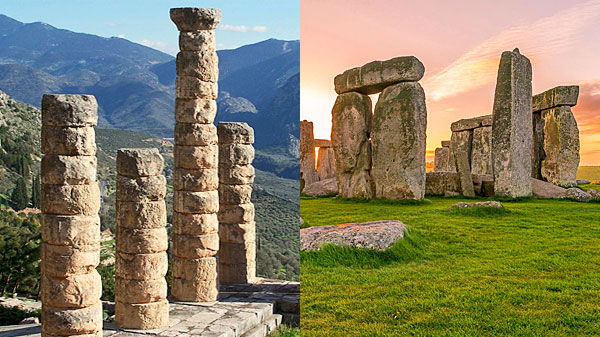While Siem Reap’s Angkor Wat and Yangon’s Shwedagon Pagoda are some of the most admired temples, we take a closer look into history to find some of world’s most ancient temples dating back to the earliest years of civilisation.
Temple of Apollo, Greece

First built around the 7th c. B.C by two legendary architects, Trophonios and Agamedes, the Temple of Apollo – located in Delphi, Greece – is a true representation of the turbulent history of this ancient site. After a fire in the 6th c. B.C, it was rebuilt as the Temple of Alcmaeonidae. This temple was of the Doric order – one of the three orders of ancient Greek and later Roman architecture – and had 6 columns at the front and 15 columns at the flanks. Following an earthquake in 373 B.C, the temple was rebuilt for the third time in 330 B.C by three architects from Corinth, resembling the The Temple of Alcmaeonidae. The foundations of the temple survive today, along with several Doric columns made of porous stone and limestone. The temple’s interior, however, leaves much to the imagination, with very little known about its arrangement.
Luxor Temple, Egypt

Located on the east bank of the River Nile, this large ancient temple was built in approximately 1400 B.C and has served as a place of worship for nearly 3,500 years. Known for its avenue of sphinxes and the towering Pylon of Ramses II, the Luxor Temple is considered the largest and most important site in ancient Egypt. Its believe that the temple was dedicated to Amun, the king of the gods, as well as the mother goddess Mut and Khonsu, god of the moon and time. Reminiscent of other Egyptian structures, the two obelisks flanking the entrance were created with the illusion that they were the same height. While the layout of the temple appears to be of equal height, illusionism enhances the relative distances, making them looking the same size to the wall behind it.
Chogha Zanbil, Iran

Built in 1250 B.C and founded by the Elamite ruler Untash-Napirisha, the Chogha Zanbil is the religious centre of Ancient Elam. The holy city contains a ziggurat, 11 temples, three palaces and a burial palace containing five royal tombs. It is believe that 22 temples were originally planned but after the city was attacked and damaged by Assyrian king Ashurbanipal around 640 B.C, it was left uncompleted. Today, the ziggurat is considered to be the best preserved example of the stepped pyramidal monument by UNESCO and in 1979, became the first Iranian site to be inscribed on the UNESCO World Heritage List.
Stonehenge, England

Though its original function remains unknown, there is a possibility that Stonehenge – one of the world’s most famous monuments – was built as a temple for the worship of ancient earth deities. Located in Wiltshire, England, the prehistoric monument consists of a ring of standing stones with each measuring around 13 feet high, 7 feet wide and weighing around 25 tons. Archaeologists believe that it was built from 3000 B.C – 2000 B.C while the surrounding circular earth bank and ditch, have been dated to 3100 B.C. Regarded as a British cultural icon, Stonehenge has been a legally protected Scheduled Ancient Monument since 1882 and were added to UNESCO’s list of World Heritage sites in 1986. Owned by the Crown and managed by English heritage, the surrounding land is owned by the National trust.
Ġgantija Temples, Malta

Built between 3600 and 3200 B.C, the two temples that make up this remarkable UNESCO World Heritage site are a representation of their powerful history. After falling into disuse around 2500 B.C the temples – made from coralline limestone – were not fully discovered by the contemporary world until the nineteenth century. Inhabitants of the island Gozo believed that they were built by a race of giants; hence the name is derived from the word ‘ġgant’, Maltese for giant. This comes as no surprise, with some of the megaliths exceeding five meters in length and weighing over fifty tons. It is believed that the large terrace at the front was used for ceremonial gatherings while remains of animal bones suggest rituals involving animal sacrifice.
If after reading this, you are inspired to go on a temple run, check out our feature detailing some of Siem Reap’s most enigmatic attractions. And for those who are feeling all templed-out, don’t fret because there is plenty to do in the city, beyond temples! Check out our guide by clicking here.
Text: Hira Desai



